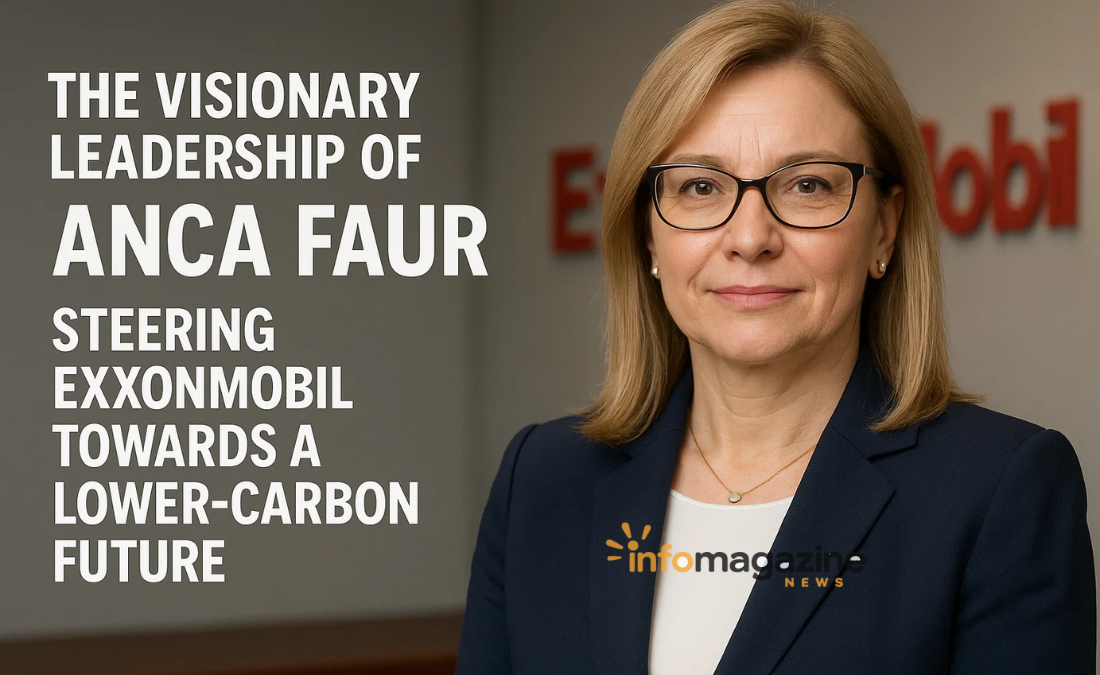In the complex and often controversial landscape of global energy, the journey toward a sustainable future is paved with innovation, strategic pivots, and decisive leadership. At the forefront of this transformation within one of the world’s largest energy companies is a key figure whose work is critical to balancing today’s energy needs with tomorrow’s environmental responsibilities. That figure is Anca Faur, the Vice President of ExxonMobil’s Low Carbon Solutions business. Her role and the initiative she leads represent a significant and telling evolution in the strategy of a traditional oil and gas supermajor, signaling a profound shift in the industry’s approach to climate change and emissions reduction.
Who is Anca Faur?
Anca Faur is a seasoned scientist and executive with a career deeply rooted in the energy sector. Holding a PhD in Chemistry, her journey with ExxonMobil spans over two decades, during which she has held a variety of technical and leadership roles. This extensive background provided her with a granular understanding of the company’s operations, from upstream exploration to downstream chemical manufacturing, before she stepped into her current pivotal position.
Her scientific expertise is not merely an academic credential; it is the foundation of her approach to the climate challenge. Dr. Faur understands the technologies, the chemical processes, and the engineering hurdles involved in decarbonization from first principles. This technical credibility, combined with her strategic business acumen, made her the ideal candidate to lead one of ExxonMobil’s most ambitious and closely watched ventures. The appointment of a scientist of her caliber to helm the Low Carbon Solutions division underscores the company’s commitment to a technology-driven approach to emissions reduction.
The Mission of ExxonMobil Low Carbon Solutions
The creation of the Low Carbon Solutions business unit in 2021 was a landmark moment for ExxonMobil. It represented an institutional acknowledgment of the climate crisis and a strategic commitment to investing billions of dollars in commercial-scale projects aimed at reducing carbon emissions. The division’s mission is multifaceted, focusing on carbon capture and storage (CCS), hydrogen production, and biofuels.
Anca Faur was tasked with a colossal responsibility: to build this new business line from the ground up and position ExxonMobil as a leader in the emerging low-carbon economy. Her mandate is to develop and deploy technologies that have the potential to make a material impact on hard-to-decarbonize industrial sectors, such as manufacturing, power generation, and commercial transportation. This involves not only technological innovation but also navigating policy landscapes, forging partnerships with governments and other industries, and making these solutions economically viable.
The Core Pillars of the Low Carbon Strategy
Under Anca Faur‘s leadership, ExxonMobil’s Low Carbon Solutions strategy is built on several core pillars, each targeting a different pathway to reduce emissions.
1. Carbon Capture and Storage (CCS)
This is arguably the centerpiece of the strategy. CCS technology involves capturing carbon dioxide (CO2) emissions at their source—like a factory or power plant—before they enter the atmosphere, transporting them, and safely injecting them deep underground for permanent storage. ExxonMobil, with its extensive experience in subsurface geology and large-scale project management from its oil and gas operations, claims a unique advantage in this area. Dr. Faur’s team is working on a portfolio of CCS projects around the world, including a massive proposed hub in the Houston Ship Channel, Texas, which could become one of the largest CCS projects ever conceived, aiming to capture millions of metric tons of CO2 per year.

2. Hydrogen
The Low Carbon Solutions business is also investing heavily in hydrogen, particularly what is known as “blue hydrogen.” This process involves producing hydrogen from natural gas but coupling it with CCS to capture the associated CO2 emissions. This results in a low-carbon fuel source that can be used for power generation, industrial heating, and heavy-duty transport. Anca Faur’s background in chemistry is directly applicable here, guiding the development of efficient and cost-effective production methods.
3. Biofuels
The third major pillar is the development of advanced biofuels. These are liquid fuels derived from non-petroleum sources like agricultural waste, algae, or other biomass. ExxonMobil is researching pathways to create biofuels that are compatible with existing vehicle engines and infrastructure, offering a potential way to decarbonize sectors like aviation, shipping, and trucking without requiring a complete overhaul of global transportation systems.
The Significance and the Challenges
The work led by Anca Faur is significant for several reasons. Firstly, it represents a major capital allocation shift within a company long synonymous with fossil fuels. This signals to investors, policymakers, and the public that the energy transition is being taken seriously at the highest levels. Secondly, the focus on CCS and blue hydrogen targets emissions from industrial sectors that are notoriously difficult to electrify, addressing a critical piece of the climate puzzle that renewable energy alone cannot solve.
However, the path is fraught with challenges. Critics argue that CCS is an unproven technology at the scale required and that it may be used to justify continued fossil fuel extraction. The economic model for CCS relies heavily on government support and a price on carbon, making it sensitive to political shifts. Furthermore, there is intense competition and rapid innovation in the low-carbon space, from renewable energy companies to electric vehicle manufacturers. Anca Faur must navigate this complex web of technical, economic, and political challenges to prove that ExxonMobil’s chosen path is not only viable but essential.
Conclusion: A Defining Role in the Energy Transition
Anca Faur is more than just an executive; she is a symbol of transition. Her leadership at ExxonMobil Low Carbon Solutions sits at the nexus of a century-old oil industry and a nascent low-carbon future. While the ultimate success of her initiatives will be measured in decades by the tonnes of CO2 sequestered and the commercial scalability of hydrogen and biofuels, her role is undeniably critical.
She embodies a pragmatic, technology-based approach to the energy transition, one that seeks to evolve existing infrastructure and expertise rather than simply abandoning it. Whether this strategy will be sufficient to meet the urgency of the climate crisis remains a subject of intense debate. What is clear, however, is that the decisions made by Anca Faur and the projects she champions will have a profound impact on the direction of one of the world’s largest energy companies and, by extension, the global effort to build a sustainable energy system for the future. Her work defines a crucial experiment in whether industrial giants can innovate their way into a new, cleaner era.




